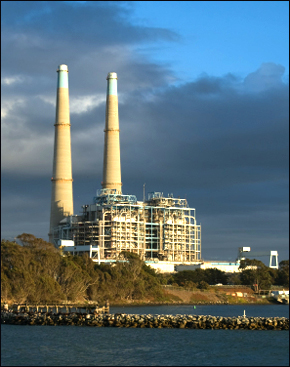California Water Board Changes Power Plant Regulations to Protect Aquatic Life
Power plants will be required to change their cooling systems to reduce the amount of water they withdraw from oceans and estuaries as a result.
 California water regulators voted on Tuesday to phase out power plant cooling systems that use water from oceans and estuaries in order to comply with federal Clean Water Act regulations, according to the Associated Press.
California water regulators voted on Tuesday to phase out power plant cooling systems that use water from oceans and estuaries in order to comply with federal Clean Water Act regulations, according to the Associated Press.
The ruling will apply to 19 power plants along the Pacific coast and the Sacramento-San Joaquin Delta, representing seven percent of the state’s electrical generating capacity. These plants use once-through cooling systems, which withdraw large volumes of water that is then returned to the water body at a much higher temperature.
Meanwhile plants within the state’s interior use closed-loop systems that withdraw comparatively little water to cope with scarcity issues.
Once-through cooling has been criticized for its collateral damage to aquatic life. Organisms can be impinged, trapped against screens over the intake pipe, or entrained, sucked into the facility’s pipe system and killed by heat. Using data collected between 2000 and 2005, the water board estimated that more than 20 billion fish larvae were entrained annually while more than 2.5 million fish were impinged.
The water board will now require that plants install ‘the best technology possible’ to ameliorate these effects to be more aligned with the language of the Clean Water Act. There are two paths for complying with the new policy: plant operators can reduce the flow of water into their pipes by 93 percent, or they need to reduce impingement and entrainment mortality by 90 percent by changing the system’s operation or intake structures.
Some power plants will be allowed to continue using the ocean as a water sources if they meet the above requirements.
Although the state’s preferred option is to implement closed-loop wet cooling systems, it will not mandate a certain technology.
“The policy is designed that each facility will decide how they will come into compliance,” said Jonathan Bishop, the board’s Chief Deputy Director, in an interview with Circle of Blue. “We set a standard, we don’t direct the method.”
Statewide costs for the changes will be known in six months when plant operators begin submitting their compliance proposals, but Bishop cautioned against the conclusion that the policy will increase the cost of electricity.
“These plants [the policy applies to] are really old and inefficient plants,” he said. “They are moving toward retirement. This ensures that when they repower they don’t repower with once-through cooling.”
Changes will be phased in over the next decade to ensure electrical service reliability. A longer time frame has been given to the Los Angeles-area because of confounding factors such as air quality requirements and the large number of facilities.
Environmental groups are largely pleased with the policy. Linda Sheehan, executive director of the California Coastkeeper Alliance told the AP that the policy had her organization’s support, though some compliance loop holes could still be closed.
Source: AP
Brett writes about agriculture, energy, infrastructure, and the politics and economics of water in the United States. He also writes the Federal Water Tap, Circle of Blue’s weekly digest of U.S. government water news. He is the winner of two Society of Environmental Journalists reporting awards, one of the top honors in American environmental journalism: first place for explanatory reporting for a series on septic system pollution in the United States(2016) and third place for beat reporting in a small market (2014). He received the Sierra Club’s Distinguished Service Award in 2018. Brett lives in Seattle, where he hikes the mountains and bakes pies. Contact Brett Walton










Leave a Reply
Want to join the discussion?Feel free to contribute!